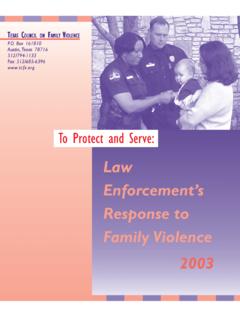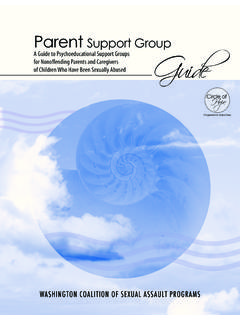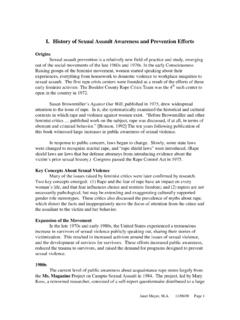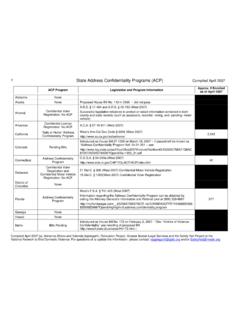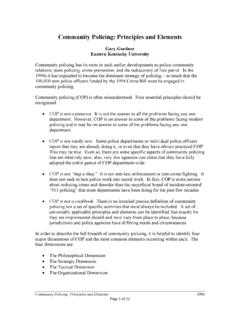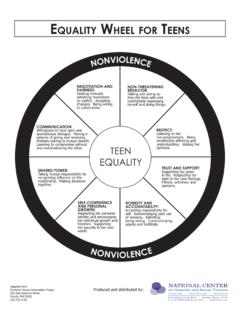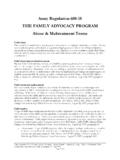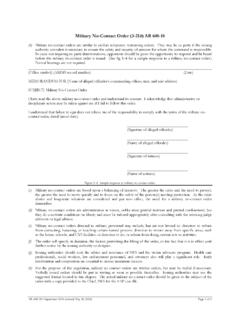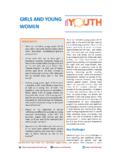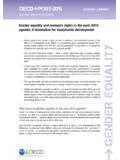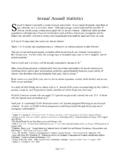Transcription of Violence Against Women
1 Violence Against Women Volume 14 Number 2 February 2008 247-261 2008 Sage Publications hosted at Advocate/Activist Note Deconstructing Male Violence Against Women The Men Stopping Violence Community-Accountability Model Ulester Douglas Dick Bathrick Phyllis Alesia Perry Men Stopping Violence Men Stopping Violence (MSV), a 24-year-old metro Atlanta-based organization that works to end male Violence Against Women , uses an ecological, community-based accountability model as the foundation of its analysis of the problem of male Violence Against Women and of its work with individuals and in communities. The MSV community-accountability model of male Violence Against Women offers a view of the cultural and historical mechanisms that support Violence Against Women . The model, and the strategies and programs that have grown out of it, demonstrate the potential for disrupting traditions of abuse and dominance at the individual, familial, local, national, and global levels.
2 Keywords: community accountability; ecological model; male Violence ; prevention Authors Note: This model and the accompanying ideas presented here are the result of 24 years of work by the Men Stopping Violence community. The authors would like to acknowledge the leadership of founding Executive Director Kathleen Carlin and current Executive Director Shelley Serdahely, whose contributions made this work possible. Beyond Batterers Intervention Since the last quarter of the 20th century, classes offered through batterers intervention programs (BIPs) have become a common strategy for working with men to intervene in cases of Violence Against Women . Although Men Stopping Violence (MSV) offers a 6-month BIP for men, this program represents only part of the larger work of the organization. MSV s analysis of male Violence Against Women indicates that greater involvement by men who are not identified as batterers involvement in the course as well as in other MSV programs has the potential for increasing the safety of the Women who live in those communities.
3 In addition to the BIP, a significant segment of MSV s work is identifying, educating, and organizing these male allies and potential male allies and includes such efforts as Men at Work: Building Safe Communities Deconstructing Male Violence Against Women 11. The Because We Have Daughters initiative, which helps men look at life through their daughters eyes, heightening their awareness of the culture of Violence and beginning the dialogue necessary to create change. The program is a series of fun and educational activities for men and their daughters but also provides opportunities for them to talk about difficult and challenging issues. 2. Community education and training: MSV provides an average of 30 community education presentations yearly to religious institutions, colleges, criminal justice organizations, other nonprofits, corporations, government agencies, and civic organizations. 3. The Community Restoration Program (CRP), which provides a setting in which volunteers and men who have successfully completed the BIP continue to give and receive support, complete community projects, and educate the community about Violence Against Women .
4 4. The MSV Internship Program, for young men who are interested in becoming allies in the work to end Violence Against Women . MSV provides mentors who demonstrate how to deconstruct long-held notions of manhood and support young men while they do the hard work of self-examination and advocacy. 5. Parenting classes, which MSV offers to address the needs of families in which Violence has destroyed the fabric of healthy parent child relationships. The program teaches effective, nonviolent parenting skills and emphasizes a collaborative approach. 6. The Mentor Training Program (MTP), which trains male college students to mentor high school boys who are having disciplinary problems and are at risk for dropping out. The MTP focuses on training mentors to rely on strategies that value education and reflect healthy definitions of masculinity. Why a Community-Centered Approach? In developing its programs and strategies, MSV uses an analysis of the global patriarchal system to educate men about the causes of male Violence Against Women .
5 This analysis uses a definition of patriarchy that closely parallels that espoused by author and activist bell hooks (2004), who writes that patriarchy is A political social system that insists that males are inherently dominating, superior to everything and anyone deemed weak, especially females, and endowed with the right to dominate and rule over the weak and to maintain that dominance through various forms of psychological terrorism and Violence . (p. 18) MSV s analysis views this political social system as an ideological, global one that is sustained and strengthened by smaller, related systems at the familial, local, and national levels. The analysis focuses on the roles of interconnected community systems in both socializing men and reinforcing patriarchal male behavior. MSV advocates a shift of focus from intervention to prevention strategies that seek to educate a critical mass of men to work in their communities.
6 In this way, not only men who are identified as batterers but all men can become potential change agents. There are a number of reasons for this community-based focus. First, research indicates that nationally, the number of men attending BIPs represents only a fraction of those who commit Violence Against Women ; most BIP participants are court-referred, but a significant number of incidents of Violence Against Women never make it to the courts. The National Institute of Justice has reported that approximately Men at Work: Building Safe Communities Deconstructing Male Violence Against Women 280% of the men participating in BIPs surveyed nationwide were court-referred (Healy, Smith, & O Sullivan, 1998). At MSV, at least 50% of men in the BIP at any one time are court-ordered. However, information gathered by the Bureau of Justice Statistics shows that between 1993 and 1998, an average of 47% of the incidents of intimate partner Violence that occurred in the United States (about 400,000 incidents) were never reported to the police (Rennison & Welchans, 2000).
7 Given all of these reasons, there is a need for solutions that engage a greater number of men in order to increase the safety of those Women and girls who do not turn to the criminal justice system for relief. Also, the make-up of intervention classes, including those conducted by MSV, does not reflect the demographic diversity of men who batter. While domestic Violence crimes are committed by men in all race and socioeconomic categories, men of color and working-class men are arrested and prosecuted for domestic Violence crimes in disproportionate numbers. Second, in interactions with men in BIP classes over the years, MSV facilitators have come to believe that community-based strategies are key to affecting lasting social change. BIP classes, therefore, are not closed and confidential but focused on men in relation to their communities. That is why the process of deconstructing the context of men s sociocultural reality has taken a central role in the work that MSV undertakes in the BIP.
8 MSV facilitators believe that without knowledge of how interconnected familial and community systems rooted in patriarchy have influenced individuals, men cannot be in possession of the tools needed for true change of their behaviors and attitudes. MSV works on the premise that gaining insight into the way their life patterns are formed and informed by patriarchal systems allows men to disrupt those patterns by coming together to support each other in the process of change and hold each other accountable for abusive and sexist behaviors. However, even those men who are somewhat successful in changing their attitudes and behaviors through work in the BIP deal with the ongoing challenge in resisting socializing patriarchal messages. This speaks to the need for a nonpatriarchal cultural paradigm and to the need for men who will create it. MSV s answer to these challenges is to develop programs outside of the realm of batterers intervention such as Because We Have Daughters and the CRP that create a climate of community accountability.
9 The organization seeks out, educates, and supports men who demonstrate both the interest and the will to take on the work of ending Violence Against Women . The MSV Community-Accountability Model The MSV community-accountability model of male Violence Against Women is a representation of the context in which Violence Against Women occurs and the foundation of a strategy that seeks community-based solutions to addressing that Violence . This ecological model is central to the work MSV does with men in the classroom and in communities, because it offers a view of the cultural and historical mechanisms that support Violence Against Women . Being able to view these mechanisms in relationship to each other assists in creating intervention and prevention strategies that have the potential to disrupt traditions of abuse and dominance. It indicates that corrective Men at Work: Building Safe Communities Deconstructing Male Violence Against Women 3actions at every level of community individual, familial, local, national, and global have the potential to shift cultural norms toward a more egalitarian standard.
10 This model allows MSV to view men batterers or not not only as individuals who sometimes engage in bad behavior but as people in relationship with their environment and with other individuals and groups that perform socializing functions. MSV s work seeks to not only intervene at different community levels to encourage individuals to change but also to train men to become catalysts who shift social norms toward nonviolent, nonsexist, nonpatriarchal manifestations. MSV views community accountability in this sense as more than sanctions imposed by the criminal legal system, social service agencies, and other government entities. MSV strategies seek to augment intervening actions from these official systems with nongovernmental actions initiated by individuals making up a number of different kinds of communities for example, family, the workplace, faith communities, and schools. Interlocking Communities The MSV Community-Accountability Model depicts five levels of community influence: the individual, the primary community, the microcommunity, the macrocommunity, and the global community.

